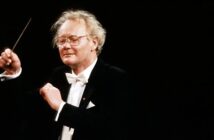The true humanity of Alma Rosé
by Norman Lebrecht / April 5, 2000
THE morning they took my neighbour Eleanor away for cremation, there arrived in the post a 1928 recording of her uncle and cousin playing the Bach double-violin concerto. Her uncle was Arnold Ros*, concertmaster of the Vienna Philharmonic Orchestra for half a century and brother-in-law of Gustav Mahler. His daughter, Alma, named after Mahler’s wife, would end her days conducting the women’s orchestra in Auschwitz.
Eleanor Ros* talked often about Alma, who had fled with her father to London in 1939, only to return to Europe. A fancified account of her Auschwitz orchestra, by Fania F*nelon, was filmed in 1980 as Playing for Time, with a script by Arthur Miller, and Vanessa Redgrave as the heroine, Fania. Alma, dubiously depicted as arrogant and cruel, was played by Jane Alexander.
Among those who protested at the distortion was Anita Lasker-Wallfisch, a cellist in the English Chamber Orchestra who recalled Alma as “a woman of immense strength and dignity . . . who helped us to survive”.
The circumstances of Alma’s death appeared to be unnatural even for Auschwitz, but so little was known about her that refuting the movie’s account seemed impossible. Who was this imposing woman who clung to musical values in a place of genocide? Why had she fled from British refuge and how exactly did she die?
These mysteries can now be resolved, as a result of 30 years’ research by a Canadian journalist and a German precision-tools engineer, working independently of one another. Richard Newman has written a biography of Alma, to be published next month by Amadeus Press. Wolfgang Wendel has issued an album of Ros* family recordings, furnished with testimonies of Auschwitz orchestra survivors.
From pieced-together shards of painful memory, there emerges a silhouette of a tantalising musician who overcame the twin handicaps of a famous name and modest talent to express a surreal humanity in the midst of mass extermination.
From her birth, on November 3, 1906, Alma was groomed for stardust by a father who had pulled himself up by his fiddle-strings from Romanian poverty to Viennese glory. Her brother, Alfred, was a weak musician. The weight of the Ros* name fell on Alma.
Early reviews from summer spas speak of her beauty rather than vivid talent.Mahler’s daughter, Anna, described her to me as a vulnerable, lovable girl. Arnold launched her in Vienna with the Bach double concerto. When the glittering dates failed to follow, Alma did the next best thing – she fell in love with a top-flight soloist.
Vasa P rihoda was as celebrated in central Europe as Heifetz was in America, a Czech violinist who could seemingly play anything twice as fast as anyone else. With Alfred’s blessing, he married Alma in 1930 – only to discover that she could neither boil an egg nor make a bed. Top violinists require a high level of spousal maintenance. When Alma could not satisfy his needs, P,rihoda looked elsewhere. He divorced her in 1935, leaving Alma devastated.
She, meanwhile, had found her musical niche as leader of the Wiener WalzermSdeln, a salon orchestra that played Viennese sweetmeats at home and abroad. She fell in love with Heini Salzer, the tall, blond son of a paper manufacturer. He was eight years her junior and extremely shy.
When Austria merged with Hitler’s Germany in March 1938, their relationship was put in jeopardy. The Ros*s were Jewish by birth, Catholic by conversion. Alma, with help from Sir Adrian Boult, brought the aged Arnold to London. Heini came too.
Alma eventually took a flat in Maida Vale and set about looking after Arnold and Heini. One day she came home to find Heini gone, flown to Vienna. Heartbroken and cut off by war, she went to neutral Holland in November 1939 to find work and make contact with Heini. Dutch music-lovers, who remembered Mahler and her father, were glad to hear her play. Heini wrote to say he was getting married.
Then the Nazis invaded Holland and her existence became precarious. Alma, charming and resourceful, gave concerts in private houses. She had a brief love affair with a Nazi officer, which may have eased her freedom of movement. When the Jews were rounded up, she entered a fictitious marriage.
Friends warned that her cover was blown and offered to hide her; she preferred to attempt an underground route to Switzerland, leaving her violin behind. Along the way, at Dijon in December 1942, she was betrayed to the Gestapo, arrested and sent to the Drancy camp outside Paris, and from there to Auschwitz.
That this pampered cultural princess should have survived the first selection at Auschwitz was itself miraculous. She was sent to the notorious medical experimentation block at Birkenau, where a Dutchwoman recognised her and told the SS that she was a famous musician.
She was given a violin and put in charge of a women’s orchestra that played jolly tunes as the prisoners trooped out and back from work each day. There are conflicting reports as to whether or not they performed as newcomers were selected for life or death.
Alma instilled fierce discipline into her band, warning that if they did not play well they might all be sent “to the gas”. Time after time, she saved members of her orchestra from instant death.
For her, music was an ideal and an escape. Excellence was its own reward. The SS addressed her respectfully as “Frau Alma”. She flew into violent rages with her musicians but never adopted the sadistic ways of other privileged prisoners, who resented her aloofness.
In April 1944 she attended a block-leader’s birthday party and came back nauseous and vomiting. Unusually, she was given a private room in the experimental hospital, with real bedding. Her stomach was pumped and she was visited by the dreaded Dr Mengele. She died two days later, on April 5.
Extraordinarily in Auschwitz, where thousands were gassed and burned daily, Alma’s body was laid out as if for burial. It was then sent for autopsy, before cremation. Why would the Nazis have investigated one death among millions?
Newman believes that her symptoms aroused suspicions of cholera, which could have infected the SS. There were also rumours that she had been poisoned by a rival block leader. The likeliest cause of death, however, was botulism, brought on by eating food from a damaged can. Among all the victims of Auschwitz, Alma Ros* managed to die an almost natural death. She was 36 years old.
One morning in 1945 (so Eleanor told me), two nuns in black called at Arnold’s door in Blackheath, handed him a violin case and departed without a word. The case contained Alma’s precious 1757 Guadagnini. It had been hidden by Dutch friends, who restored it to her ailing father. He sold the instrument to the Viennese-born concertmaster of the Metropolitan Opera in New York, where its sweet tone was heard for two decades.
Years later, at Eleanor’s obsequies in 1992, we put on the disc of the two Ros*s playing Bach. It is the only sound of Alma’s to survive.
Share:












